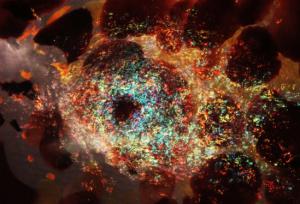Content:
New research conducted in the UC Santa Barbara lab of Daniel Morse, professor emeritus in the Department of Molecular, Cellular and Developmental Biology (MCDB), demonstrates that the squid's ability to "tune" its colors is correlated with the presence of specific sequences of reflectins, proteins unique to the light-sensing tissue of cephalopods. The findings appear in the Journal of Biological Chemistry.
While the diverse optical behaviors of cephalopod tissues have been attributed to reflectins for almost a decade, this work shows for the first time how reflectin protein subtype structure, localization, distribution and relative abundance correlate with the squid's optical output. Building on the lab's previous work, the new research details the mechanisms of the animal's tunable (adaptive) and nontunable (static) iridocytes. Specialized cells in squid skin, iridocytes -- also known as iridophores -- produce color via Bragg reflection, by which light is reflected in a very regular and predictable manner.


